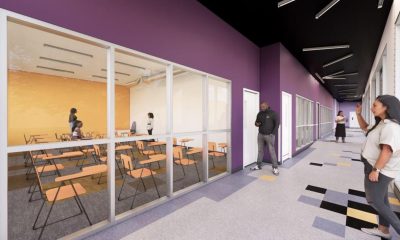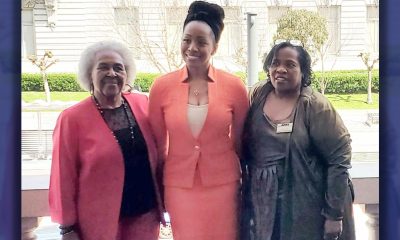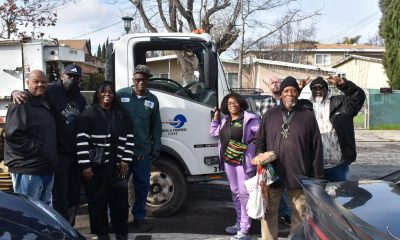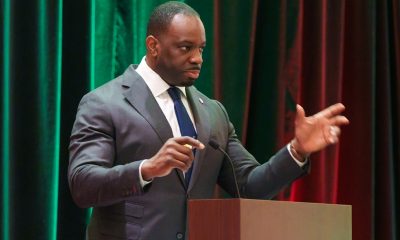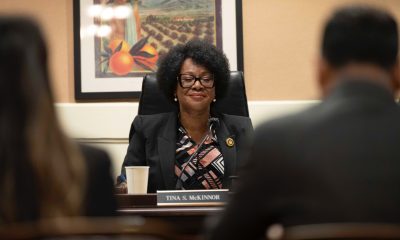Bay Area
Black Educators Discuss Education Equity Ahead of School Re-Opening This Fall
The three-day conference was divided into a total of six morning and afternoon plenary lectures and attendees had access to their choice of 55 seminars and workshops that supported the conference goals.

The California Association of African-American Superintendents and Administrators (CAAASA) held their 13th annual professional development summit May 26 – 28th in San Diego. The theme for this year’s conference was, “Achieving an Equity Driven Education.”
Co-hosted by the San Diego County Office of Education and Moreno Valley Unified School District, the conference was held in-person and virtually. For their safety, in-person participants were required to have been vaccinated or to have tested negative for COVID-19.
According to Dr. Daryl Camp, CAAASA president and superintendent of the San Lorenzo Unified School District, “CAAASA was one of the last organizations to host an in-person conference in 2020 and will be the first organization to host an in-person conference in 2021.”
CAAASA welcomed about 150 in-person attendees. About 600 other participants joined the conference online. Those attending were education practitioners, including school administrators, teachers, and staff; education researchers; policymakers; and community members inspired and motivated to learn ways to improve the educational experiences and outcomes for African American and other students of color by promoting equity and social justice and improved school climates.
The conference theme, “Achieving an Equity Driven Education” acknowledges the need, “to ensure the next normal will achieve an equity driven education for students,” says Camp. “While the pandemic has presented many challenges, it has also provided an opportunity to re-envision what an equity-driven education may look like for underserved students.”
The conference was organized around seven goals:
- Align strategies that promote access to excellence for boys and girls of color;
- Utilize Social Emotional Learning (SEL) supports to address the impact of trauma and poverty on learning and academic achievement;
- Use assessment data (Single Plan for Student Achievement – SPSAs) and Local Control and Accountability Plans (LCAP) as strategic and equity-driven tools to positively impact academic achievement;
- Increase meaningful family engagement and identify strategies and resources to improve graduation rates and increase college readiness and access for students of color;
- Provide strategies to ensure the safety and wellbeing of youth in school and the community, including issues such as violence, social justice concerns, bullying and human trafficking;
- Address school climate, including student discipline, suspension, expulsion, truancy and chronic absenteeism;
- Increase awareness about the advantages and values of early childhood education.
The three-day conference was divided into a total of six morning and afternoon plenary lectures and attendees had access to their choice of 55 seminars and workshops that supported the conference goals.
The opening plenary was titled “National Health & Educational Concerns Due to the Impact of COVID-19.” The speakers were Dr. Robert Ross, president and CEO of The California Endowment; Dr. Theopia Jackson, president of the Association of Black Psychologists; and Dr. Nana Efua B. Afoh-Manin, founder of myCovidMD. They spoke about depression, anxiety, stress, isolation and the increasing number of Black students contemplating and committing suicide due to impact of the COVID-19 Pandemic, among other factors.
The afternoon plenary was “Black Girls Institute: Challenges & Crises Faced by Black Girls in Public Schools & Society.” It addressed issues related to how girls of color are bearing the brunt of policies and practices that diminish their opportunities and harm their potential. The panel was moderated by Dr. Sonjhia Lowery, Superintendent, Old Adobe Union School District.
On day two, the morning plenary was “Addressing Education and Economic Empowerment for African Americans and Other Communities of Color.” Congresswoman Barbara Lee (D-CA-13); Marc Morial, president and CEO of the National Urban League; and Dr. Michael Drake, president of the University of California spoke about the financial wealth gap and the resultant challenges to education and life in the African American and other communities of color.
The afternoon of day two plenary was the “Research Institute Panel Discussion: Achieving An Equity-Driven Education – Post COVID.” This is CAAASA’s annual research institute panel that provided views on what an equity-driven education looks like once the COVID pandemic ends.
On day three, the morning plenary session was titled “Shared Educational Inequities, Discrimination, Disparities and Commonalities for BIPOC (Black, Indigenous and People of Color).” This panel featured members of the BIPOC community, and it addressed common disparities that each community has faced within the educational system. Topics discussed included inequity and discrimination within the school systems.
The closing plenary was called “Ensuring, Increasing and Providing Digital Equity in Schools, Homes and Communities.” This panel discussed ways to enhance capabilities to close the divide and ensure that African American and other students of color are able to stay connected and up to date. The Digital Divide was brought to the spotlight due to the COVID-19 pandemic.
CAAASA was founded in 1993 and is committed to identifying and addressing the critical issues in education through public policy relative to the status and performance of African-American students in California.
A complete description of the conference workshops and list of presenters can be found at https://www.caaasa.org/
Alameda County
DA Pamela Price Stands by Mom Who Lost Son to Gun Violence in Oakland
Last week, The Post published a photo showing Alameda County District Attorney Pamela Price with Carol Jones, whose son, Patrick DeMarco Scott, was gunned down by an unknown assailant in 2018.
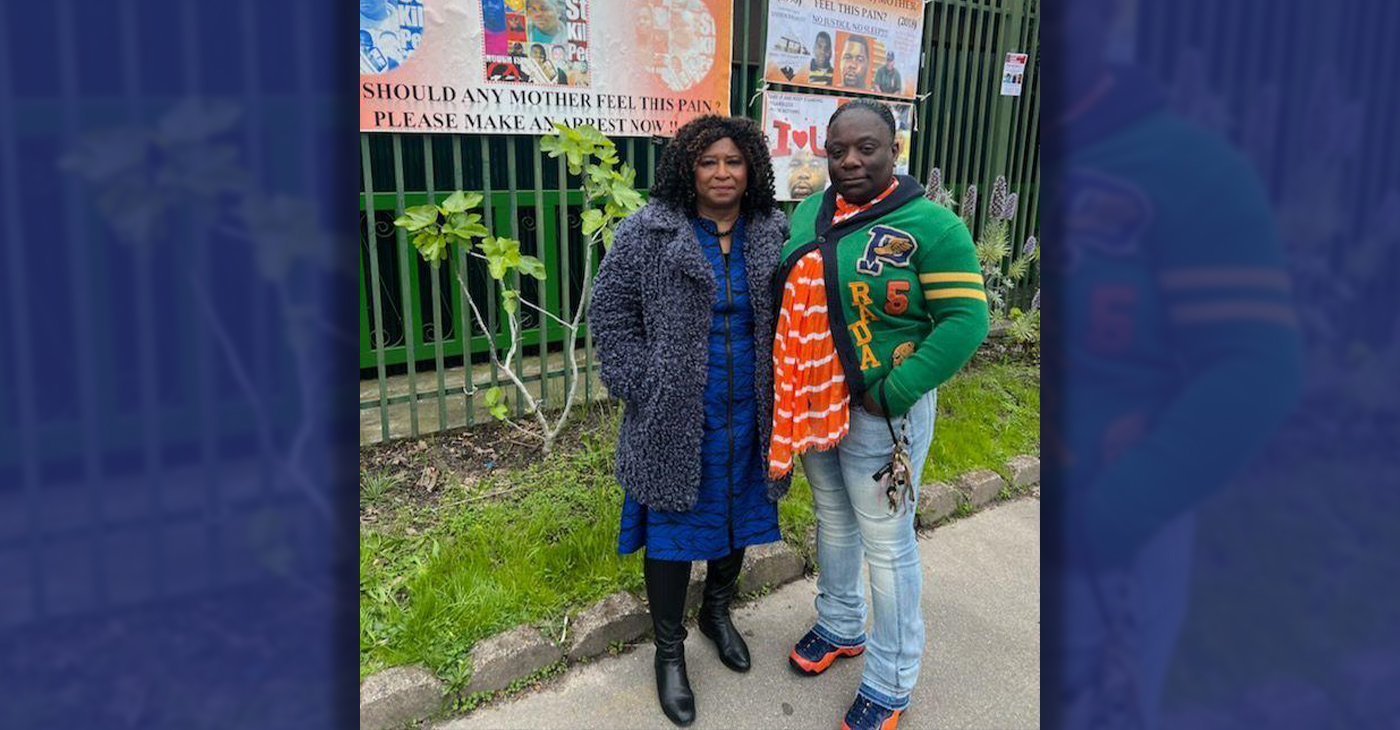
Publisher’s note: Last week, The Post published a photo showing Alameda County District Attorney Pamela Price with Carol Jones, whose son, Patrick DeMarco Scott, was gunned down by an unknown assailant in 2018. The photo was too small for readers to see where the women were and what they were doing. Here we show Price and Jones as they complete a walk in memory of Scott. For more information and to contribute, please contact Carol Jones at 510-978-5517 at morefoundation.help@gmail.com. Courtesy photo.
Bay Area
State Controller Malia Cohen Keynote Speaker at S.F. Wealth Conference
California State Controller Malia Cohen delivered the keynote speech to over 50 business women at the Black Wealth Brunch held on March 28 at the War Memorial and Performing Arts Center at 301 Van Ness Ave. in San Francisco. The Enterprising Women Networking SF Chapter of the American Business Women’s Association (ABWA) hosted the Green Room event to launch its platform designed to close the racial wealth gap in Black and Brown communities.
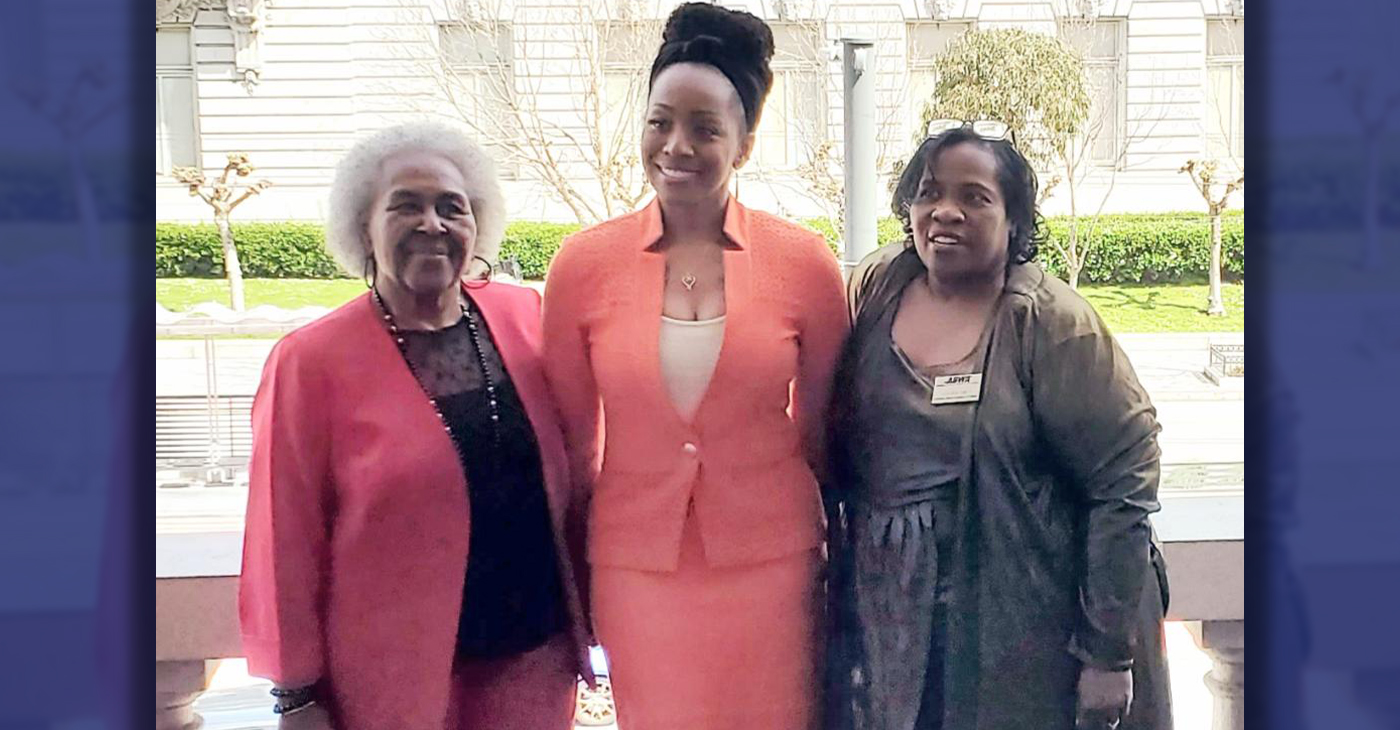
By Carla Thomas
California State Controller Malia Cohen delivered the keynote speech to over 50 business women at the Black Wealth Brunch held on March 28 at the War Memorial and Performing Arts Center at 301 Van Ness Ave. in San Francisco.
The Enterprising Women Networking SF Chapter of the American Business Women’s Association (ABWA) hosted the Green Room event to launch its platform designed to close the racial wealth gap in Black and Brown communities.
“Our goal is to educate Black and Brown families in the masses about financial wellness, wealth building, and how to protect and preserve wealth,” said ABWA San Francisco Chapter President LaRonda Smith.
ABWA’s mission is to bring together businesswomen of diverse occupations and provide opportunities for them to help themselves and others grow personally and professionally through leadership, education, networking support, and national recognition.
“This day is about recognizing influential women, hearing from an accomplished woman as our keynote speaker and allowing women to come together as powerful people,” said ABWA SF Chapter Vice President Velma Landers.
More than 60 attendees dined on the culinary delights of Chef Sharon Lee of The Spot catering, which included a full soul food brunch of skewered shrimp, chicken, blackened salmon, and mac and cheese.
Cohen discussed the many economic disparities women and people of color face. From pay equity to financial literacy, Cohen shared not only statistics, but was excited about a new solution in motion which entailed partnering with Californians for Financial Education.
“I want everyone to reach their full potential,” she said. “Just a few weeks ago in Sacramento, I partnered with an organization, Californians for Financial Education.
“We gathered 990 signatures and submitted it to the [California] Secretary of State to get an initiative on the ballot that guarantees personal finance courses for every public school kid in the state of California.
“Every California student deserves an equal opportunity to learn about filing taxes, interest rates, budgets, and understanding the impact of credit scores. The way we begin to do that is to teach it,” Cohen said.
By equipping students with information, Cohen hopes to close the financial wealth gap, and give everyone an opportunity to reach their full financial potential. “They have to first be equipped with the information and education is the key. Then all we need are opportunities to step into spaces and places of power.”
Cohen went on to share that in her own upbringing, she was not guided on financial principles that could jump start her finances. “Communities of color don’t have the same information and I don’t know about you, but I did not grow up listening to my parents discussing their assets, their investments, and diversifying their portfolio. This is the kind of nomenclature and language we are trying to introduce to our future generations so we can pivot from a life of poverty so we can pivot away and never return to poverty.”
Cohen urged audience members to pass the initiative on the November 2024 ballot.
“When we come together as women, uplift women, and support women, we all win. By networking and learning together, we can continue to build generational wealth,” said Landers. “Passing a powerful initiative will ensure the next generation of California students will be empowered to make more informed financial decisions, decisions that will last them a lifetime.”
Bay Area
MAYOR BREED ANNOUNCES $53 MILLION FEDERAL GRANT FOR SAN FRANCISCO’S HOMELESS PROGRAMS
San Francisco, CA – Mayor London N. Breed today announced that the U.S. Department of Housing and Urban Development (HUD) has awarded the city a $53.7 million grant to support efforts to renew and expand critical services and housing for people experiencing homelessness in San Francisco.
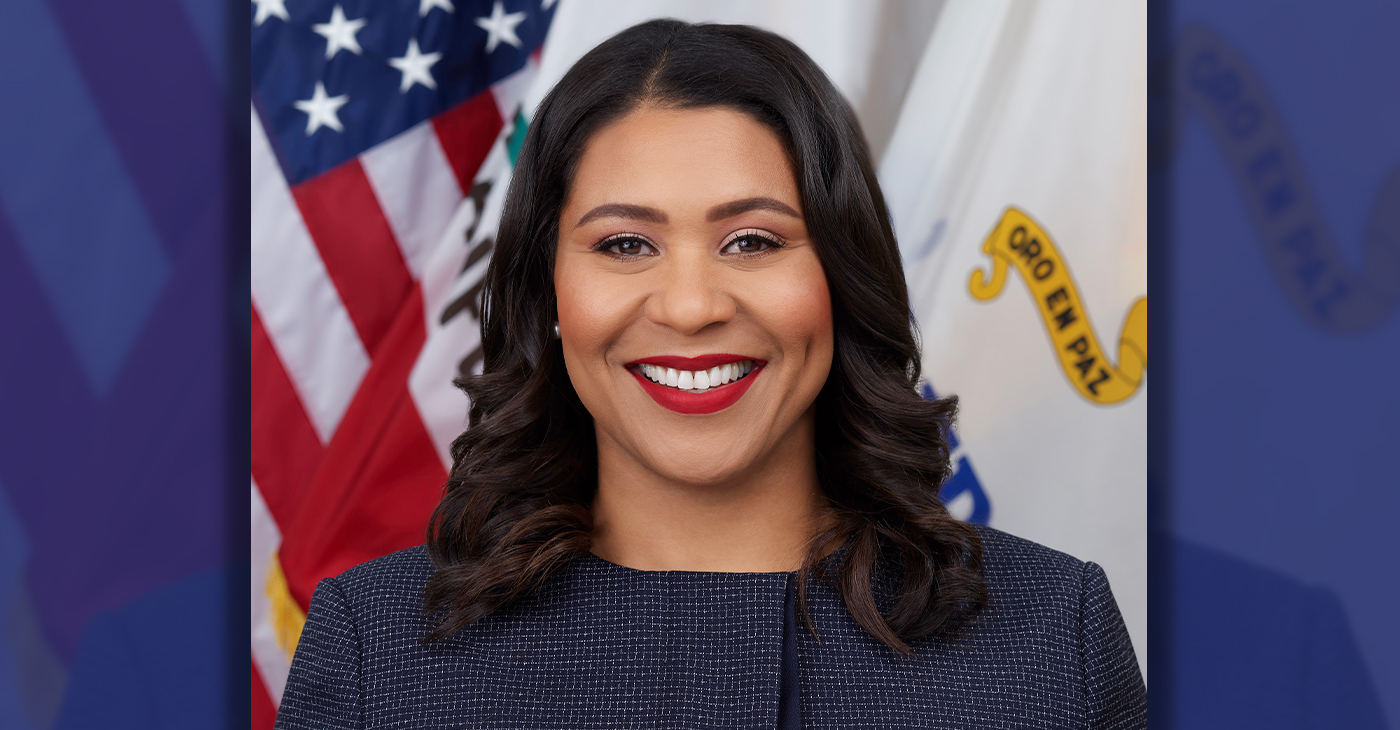
FOR IMMEDIATE RELEASE:
Wednesday, January 31, 2024
Contact: Mayor’s Office of Communications, mayorspressoffice@sfgov.org
***PRESS RELEASE***
MAYOR BREED ANNOUNCES $53 MILLION FEDERAL GRANT FOR SAN FRANCISCO’S HOMELESS PROGRAMS
HUD’s Continuum of Care grant will support the City’s range of critical services and programs, including permanent supportive housing, rapid re-housing, and improved access to housing for survivors of domestic violence
San Francisco, CA – Mayor London N. Breed today announced that the U.S. Department of Housing and Urban Development (HUD) has awarded the city a $53.7 million grant to support efforts to renew and expand critical services and housing for people experiencing homelessness in San Francisco.
HUD’s Continuum of Care (CoC) program is designed to support local programs with the goal of ending homelessness for individuals, families, and Transitional Age Youth.
This funding supports the city’s ongoing efforts that have helped more than 15,000 people exit homelessness since 2018 through City programs including direct housing placements and relocation assistance. During that time San Francisco has also increased housing slots by 50%. San Francisco has the most permanent supportive housing of any county in the Bay Area, and the second most slots per capita than any city in the country.
“In San Francisco, we have worked aggressively to increase housing, shelter, and services for people experiencing homelessness, and we are building on these efforts every day,” said Mayor London Breed. “Every day our encampment outreach workers are going out to bring people indoors and our City workers are connecting people to housing and shelter. This support from the federal government is critical and will allow us to serve people in need and address encampments in our neighborhoods.”
The funding towards supporting the renewal projects in San Francisco include financial support for a mix of permanent supportive housing, rapid re-housing, and transitional housing projects. In addition, the CoC award will support Coordinated Entry projects to centralize the City’s various efforts to address homelessness. This includes $2.1 million in funding for the Coordinated Entry system to improve access to housing for youth and survivors of domestic violence.
“This is a good day for San Francisco,” said Shireen McSpadden, executive director of the Department of Homelessness and Supportive Housing. “HUD’s Continuum of Care funding provides vital resources to a diversity of programs and projects that have helped people to stabilize in our community. This funding is a testament to our work and the work of our nonprofit partners.”
The 2024 Continuum of Care Renewal Awards Include:
- $42.2 million for 29 renewal PSH projects that serve chronically homeless, veterans, and youth
- $318,000 for one new PSH project, which will provide 98 affordable homes for low-income seniors in the Richmond District
- $445,00 for one Transitional Housing (TH) project serving youth
- $6.4 million dedicated to four Rapid Rehousing (RRH) projects that serve families, youth, and survivors of domestic violence
- $750,00 for two Homeless Management Information System (HMIS) projects
- $2.1 million for three Coordinated Entry projects that serve families, youth, chronically homeless, and survivors of domestic violence
In addition, the 2023 CoC Planning Grant, now increased to $1,500,000 from $1,250,000, was also approved. Planning grants are submitted non-competitively and may be used to carry out the duties of operating a CoC, such as system evaluation and planning, monitoring, project and system performance improvement, providing trainings, partner collaborations, and conducting the PIT Count.
“We are very appreciative of HUD’s support in fulfilling our funding request for these critically important projects for San Francisco that help so many people trying to exit homelessness,” said Del Seymour, co-chair of the Local Homeless Coordinating Board. “This funding will make a real difference to people seeking services and support in their journey out of homelessness.”
In comparison to last year’s competition, this represents a $770,000 increase in funding, due to a new PSH project that was funded, an increase in some unit type Fair Market Rents (FMRs) and the larger CoC Planning Grant. In a year where more projects had to compete nationally against other communities, this represents a significant increase.
Nationally, HUD awarded nearly $3.16 billion for over 7,000 local homeless housing and service programs including new projects and renewals across the United States.
-

 Activism4 weeks ago
Activism4 weeks agoOakland Post: Week of March 27 – April 2, 2024
-

 #NNPA BlackPress4 weeks ago
#NNPA BlackPress4 weeks agoCOMMENTARY: D.C. Crime Bill Fails to Address Root Causes of Violence and Incarceration
-

 #NNPA BlackPress4 weeks ago
#NNPA BlackPress4 weeks agoFrom Raids to Revelations: The Dark Turn in Sean ‘Diddy’ Combs’ Saga
-

 #NNPA BlackPress4 weeks ago
#NNPA BlackPress4 weeks agoMayor, City Council President React to May 31 Closing of Birmingham-Southern College
-

 #NNPA BlackPress4 weeks ago
#NNPA BlackPress4 weeks agoBaltimore Key Bridge Catastrophe: A City’s Heartbreak and a Nation’s Alarm
-

 #NNPA BlackPress4 weeks ago
#NNPA BlackPress4 weeks agoBaltimore’s Key Bridge Struck by Ship, Collapses into Water
-

 #NNPA BlackPress4 weeks ago
#NNPA BlackPress4 weeks agoBeloved Actor and Activist Louis Cameron Gossett Jr. Dies at 87
-

 Community1 week ago
Community1 week agoFinancial Assistance Bill for Descendants of Enslaved Persons to Help Them Purchase, Own, or Maintain a Home

